Parallel signals of democracy and dictatorship
The Philippines and the United States share an intertwined political history that continues to echo with uncanny parallels. Often perceived as an asymmetric reflection of American democratic ideals, the Philippines has evolved into a signal bearer, foreshadowing the political trajectory of its Western counterpart. There are five critical “signals” that offer insights into parallel challenges and opportunities that both democracies face in preserving their institutional integrity and democratic values.
The first signal traces back to the early 1990s, following the Philippine Senate’s decision to terminate the US bases agreement, leading to the closure of American military installations in Clark and Subic. In a dismissive stance, the US disregarded crucial intelligence from Filipino authorities about a terrorist plot that would later materialize as the 9/11 attacks. This intelligence, uncovered accidentally during a fire in Malate, Manila, revealed plans to crash airplanes into major US landmarks.
The Philippines became a testing ground for social media manipulation in the 2016 elections, leading to Rodrigo Duterte’s rise to power. The same tactics associated with Cambridge Analytica—propaganda, disinformation, and microtargeting—later surfaced in the 2016 US elections, resulting in Donald Trump’s victory. Both elections highlight how technology, when weaponized, can undermine democratic processes and distort public discourse. The parallels between Duterte and Trump—populist rhetoric, disdain for traditional political norms, and reliance on an “army of trolls”—illustrate the global nature of this challenge.
The 2022 Philippine elections presented another cautionary tale. Leni Robredo’s decision to run late in the presidential race mobilized massive crowds but ultimately fell short against Ferdinand Marcos Jr. and Sara Duterte’s well-funded, populist campaign. Robredo’s failure to connect with economically struggling voters in Classes D and E mirrored challenges faced by Kamala Harris and other progressive US politicians, who have struggled to resonate beyond urban and educated constituencies. The lesson is clear: A successful campaign requires not just visible enthusiasm but also deep engagement with economically marginalized but silent communities.
The fourth signal is a stark warning about authoritarianism. In 1972, Ferdinand Marcos Sr. declared martial law in the Philippines, leveraging the 1935 Constitution’s “commander in chief” provision to consolidate power. His regime manipulated the military and judiciary to rubber-stamp his dictatorship. Today, similar ambitions resonate in the US, where Trump signals his intention to leverage the Insurrection Act to centralize power, weaken institutional checks, and use the military to enforce radical policies.
However, the Philippine experience offers a counter-narrative: Duterte’s failed attempt to involve the military in his war on drugs demonstrated that institutional loyalty to the Constitution can resist authoritarian overreach. The US military, steeped in a tradition of constitutional adherence, may hold the line against any similar drift toward despotism.
Perhaps the most critical lesson from the Philippines is the role of active citizen opposition in defending democracy. The 1986 Edsa People Power Revolution, which toppled the Marcos dictatorship, was a spontaneous, overwhelming display of collective will. This moral fiber—a populace united in opposition to tyranny—is the ultimate safeguard against authoritarianism. For the US, the challenge is to foster this same level of civic engagement, ensuring that democratic norms are not eroded by complacency or polarization.
The striking parallels between the Philippines and the US are not coincidental. As the only country whose Constitution and democratic framework mirror those of the US, the Philippines has often reflected the strengths and vulnerabilities of American democracy. From the 1935 to the 1987 Philippine Constitutions, the legal and institutional systems of the Philippines have been deeply influenced by the American model.
Despite this shared legacy, the Philippine military has shown a remarkable recovery from the institutional corrosion inflicted during Marcos Sr.’s martial law years. Today, it stands as a constitutional and patriotic institution, committed to defending the West Philippine Sea and upholding democratic values. This transformation offers hope that the US military, grounded in its traditions of constitutional loyalty, can similarly resist any attempts to undermine democracy from within.
The Philippines serves as both a mirror and a warning to the US. The echoes of history—from overlooked intelligence to manipulated elections, authoritarian drift, and the power of civic resistance—resonate across the Pacific. In this interconnected world, the lessons from one democracy are invaluable to another. The challenge for both nations is to remain vigilant, fostering institutions and civic cultures resilient enough to withstand the pressures of authoritarianism and disinformation.
—————
doyromero@gmail.com





















